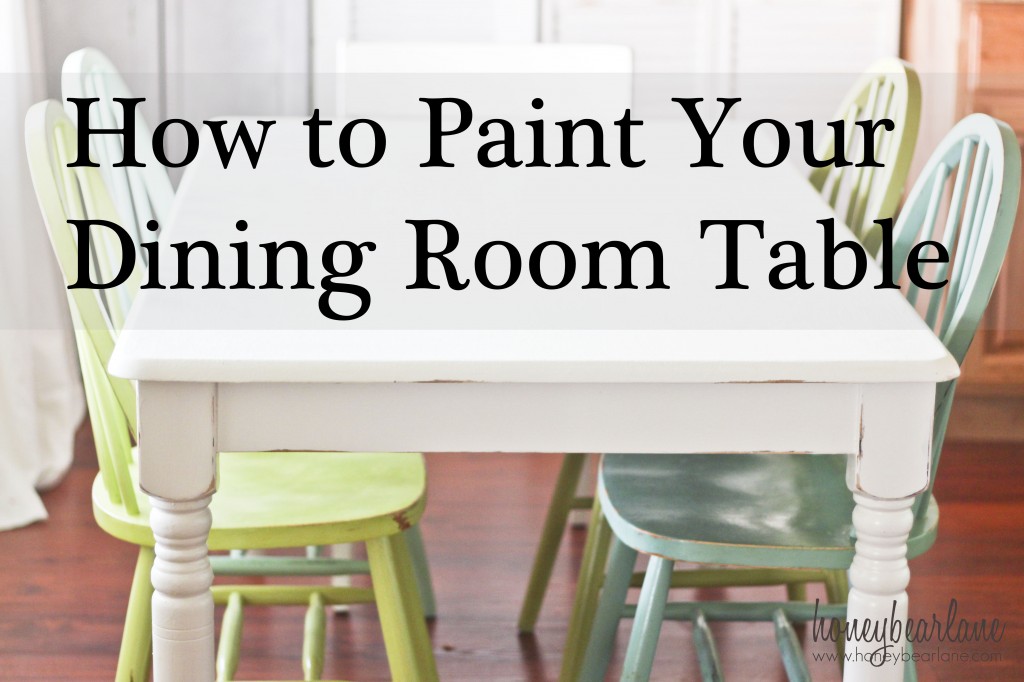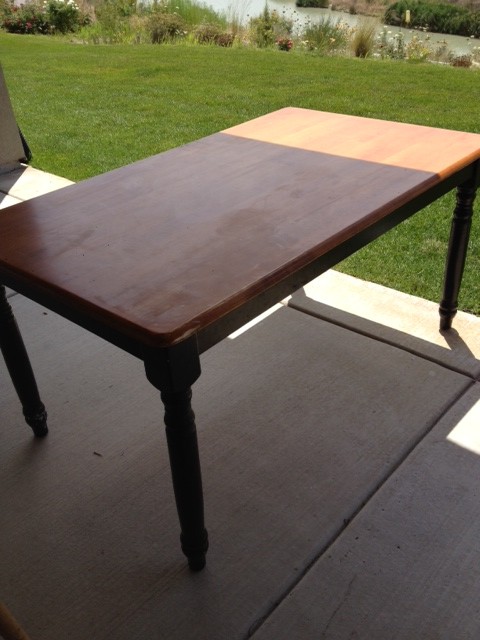Painting the Dining Room Table: A Survivor’s Story
This is kind of a long story. If you want to read it cause you love me, then feel free to settle into a good DIY tale. If you are just stopping in for the facts, here they are below:
How to Paint a Dining Room Table
- Prep: Sand, degloss, sand some more. Make sure that you do NOT have a slick surface in any way. Dining room tables have a lot of laquer and your paint won’t stick to the surface unless you rough that top up.
- Prime: I like oil based primers. I would have painted on the KILZ but I just happened to have it in spray form. One or two good coats.
- Paint: Paint as many coats to get a nice thick color and let the coats dry about 4 hours in between. Let the paint cure for at least 24 hours before distressing.
- Distress: If you choose to do this step, be careful. Don’t just go all willy-nilly with your sander. In fact, just use a sand bar or sandpaper. The worst thing is to pull up too much paint and then have it look like a giant disaster rather than old and worn.
- Seal: This part is very important! Do at least 5 coats of sealer (polycrylic for white or polyurethane for other colors) and remember that it won’t fully cure for about a month so be careful with the surface.
And now onto the juicy details of which I wish I had more pictures of. But I was seriously so frustrated that why would I take pictures??
Painting the Dining Room Table: A Survivor’s Story
Four words for this project: Pain. In. The. Butt.
When I started painting my dining room table, I’d already successfully painted the TV hutch, two bookcases, four chairs, a train table, and a desk. I thought, ‘no sweat! I’ll do everything just like I did with the others.’ WRONG-O!
So I dragged this baby outside and shined it up real good with my liquid sandpaper (aka deglosser.) Then I got out my sander and went over all the surfaces lightly. That’s usually enough for a solid wood piece.
Well here’s where I made my grave error: I started painting with the paint–not priming first. I didn’t really think of it because I’d used the paint successfully before but I forgot that it didn’t already have primer in it, like the Glidden and Behr brand paints I’d recently purchased. So I spent an hour painting it and I thought I had a good start. A little while later (not long enough though–I’m always so impatient) I took out the sander to sand between coats and BAM! Paint started peeling off like peeling an orange.
{CRY!!!}
I scratched a couple areas and sure enough, the paint peeled off easily, like I’d painted laminate. Did you know that dining room tables have like a million coats of laquer on them? Such that if you don’t sand it off, no latex will stick to it.
Commence the excruciating next 24 hours of me sanding and scraping off ALL the white paint I’d just painted on. Holy cow I wanted to die. I was working in the hot sun, with dust and paint specks flying everywhere, stepping on giant gooey gobs of paint that I’d scraped off by using paint remover. I looked like a chimney sweep after I was done–black smudges all over my face and body. Seriously, awful.
I wouldn’t mind removing paint if I wanted to restore a piece , knowing that an amazing piece lay waiting to be stained. But removing paint that I had just painted hours before was just a sad story. I felt dumb and frustrated. But everyone has fails now and then.
Moving on! After I had sanded it to death, I wiped it down with mineral spirits and then sprayed it with KILZ oil-based primer. That paint is gonna stick, baby! One problem you may run into is that your latex paint might separate from your oil based. If you find this happening, be very careful with distressing. Let your paint cure for longer before distressing.
I painted I think four coats of white paint. After each coat dried I sanded it down with a 220 grit sandpaper, just a little to smooth it down. Then I distressed just a little, on the edges. When I was satisfied, I painted 8, yes EIGHT coats of Minwax polycrylic over the top. And I sanded in between a couple of the coats, but not all. I chose Polycrylic rather than polyurethane because polyurethane can cause yellowing on white paint over time.
Why so many coats, Heidi? Because dining room tables get WORKED, especially mine. They are scrubbed down every day after being covered oatmeal and cheerios, vegetable juice, and whatever else my kids spill.
And now that it’s done I love it. I really do. It looks so much better! Totally worth the hassle.



It looks beautiful Heidi! I think we have the same table and I’ve been wanting to paint it but now I’m not so sure. I get frustrated to easily. Do you want to come paint mine too?
Thank you SO much for all of the info! I painted my dining table & chairs last year & they are all chipped & ruined already. I need to either strip them or start over with a new used set I find. I’m pinning this to remember for when I re-re-do mine again. Thanks!!!!
LOL………..It looks great now. Good to know I’m keeping this info for future reference.
I would love to do this to our dining room table (and paint the chairs like yours, too) but now I’m very SCARED! LOL
You are amazing! Love your kitchen table and chairs redo! I have the same set and have been wanting to get a new one,but gonna try this first! Thank you for the tutorials! Can i ask what color and brand of white you used for your table? Thanks!
I’m kicking myself because I can’t figure out what shade of white it was but the brand is Glidden from Home Depot.
Was wondering if you found any sort of literature saying the Minwax stuff was safe enough for a table – I’m having difficulty finding one that is okay to eat off of!
Thanks!
LOVE this table and chairs. I just purchased a table yesterday and plan to start refinishing it in about a week or so. Now that it has been a few months, I am wondering how it is holding up. Anything you might do differently? This table has already been painted on the legs/apron. I am planning on roughing them up with an electric sander and then priming and painting. Thoughts? Thanks for the inspiration!
Go for it! Just test a small area of paint to see it if scratches off once you’ve painted it on and it’s dried. If it scratches off super easy, I would prep the surface better, sand down, etc.
Thank you so much for blogging your experience. I’m getting ready to paint quite a few things, one being my dining room table (ugh this one scares me). I pretty much have all the steps down..sanding,deglossing,priming,painting..I plan on doing some fine sanding in between primer/paint coats and again after each paint coat.. then again, after a some poly coats.. My question is this. Do you sand the last “Ok, this thing is done” coat of poly? or do you leave it as it is since the piece has enough on it and it’s finished to completion.
Thank you for any help you can give
Look Awesome! Do you remember the name of the blue color you used on your chairs ?
The darker one is Martha Stewart yucca plant. I can’t remember the other but it’s listed in the Ombre Windsor Chairs post.
hey! what’s the status of the table? still in good condition? a neighbor asked if i could paint her dining room table, and while I can paint furniture well, I’ve never done a dining table. I want to make sure I do it RIGHT! So. Eight polycrylic coats good? Or should I shoot for ten? 😀
It’s chipped in a few places. I will probably strip the paint in a couple years and refinish it with stain. It’s hard to keep a white table looking nice.
Hi, Heidi! I found your post on Pinterest! I’ve read several of your DIY blogs before, and used your slip cover post to as a reference when I finally got up the nerve to do mine! But today I have a specific question: Have you had any issues with your Minwax polycrylic being “soft”? I’ve refinished every piece of furniture in my living room and even a year later I can still mark the surfaces with my finger nail. Understandably, with four kids, this leaves me with a mortal dread of using it on my dining room table. I’m hoping that maybe I just got a bad can or something!
Hmmm…I don’t think so but I haven’t used polycrylic that much. For this particular post, when I painted the table white, it only lasted about a year. It chipped rather easily and actually wasn’t super hard like I was hoping. I’m not sure why that happened. I ended up pulling all the paint off the top (literally pulling in sheets which goes to show you how well it adhered to the surface to start) and restaining it. From now on I use DecoArt Soft Touch Varnish for finishing because it is very easy to work with, has the soft wax-like touch but you don’t have to buff or anything, just paint it on.
How do you apply the decoArt soft touch without getting the awful bubbles??!!
Oh hmm, sorry you’re having that problem! I’m not sure, I’ve never had an issue with them drying as bubbles. Maybe just make sure to stir it really well instead of shaking it. Good luck!
Be sure that all of your site content are ones that only you own the rights too.
How you do the most of this opportunity is entirely to you.
You can use trivia questions if require to. https://918kiss.poker/casino-games/72-playboy-casino